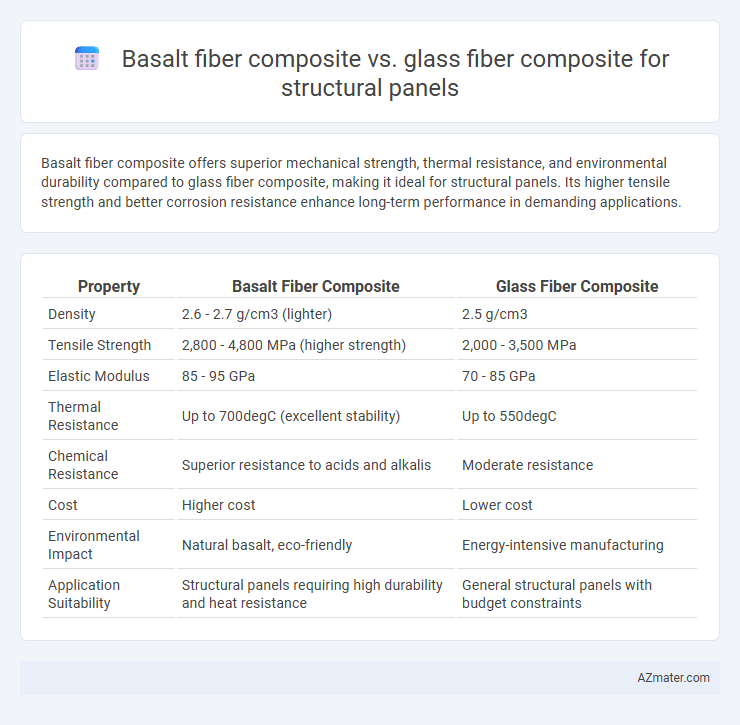Basalt fiber composite offers superior mechanical strength, thermal resistance, and environmental durability compared to glass fiber composite, making it ideal for structural panels. Its higher tensile strength and better corrosion resistance enhance long-term performance in demanding applications.
Table of Comparison
| Property | Basalt Fiber Composite | Glass Fiber Composite |
|---|---|---|
| Density | 2.6 - 2.7 g/cm3 (lighter) | 2.5 g/cm3 |
| Tensile Strength | 2,800 - 4,800 MPa (higher strength) | 2,000 - 3,500 MPa |
| Elastic Modulus | 85 - 95 GPa | 70 - 85 GPa |
| Thermal Resistance | Up to 700degC (excellent stability) | Up to 550degC |
| Chemical Resistance | Superior resistance to acids and alkalis | Moderate resistance |
| Cost | Higher cost | Lower cost |
| Environmental Impact | Natural basalt, eco-friendly | Energy-intensive manufacturing |
| Application Suitability | Structural panels requiring high durability and heat resistance | General structural panels with budget constraints |
Introduction to Basalt and Glass Fiber Composites
Basalt fiber composites are made from natural volcanic rock and offer superior tensile strength, thermal stability, and corrosion resistance compared to traditional glass fiber composites derived from silica-based materials. Glass fiber composites remain widely used in structural panels due to their lower cost, good mechanical properties, and ease of manufacture. Advances in basalt fiber technology position it as a sustainable and high-performance alternative for structural applications requiring enhanced durability and environmental resistance.
Material Composition and Manufacturing Processes
Basalt fiber composites consist of natural volcanic rock fibers, offering higher tensile strength and thermal stability compared to glass fiber composites, which are primarily made from silica-based glass fibers. The manufacturing process for basalt fiber composites involves melting basalt rock at approximately 1400degC, followed by fiber extrusion and weaving, while glass fiber composites are produced by melting raw materials at around 1500degC and fiberizing through a drawing process. These differences in material composition and manufacturing result in basalt fiber composites providing enhanced durability and environmental resistance, making them suitable for advanced structural panel applications.
Mechanical Properties Comparison
Basalt fiber composites exhibit superior tensile strength and impact resistance compared to glass fiber composites, making them more suitable for structural panel applications requiring enhanced durability. The higher modulus of elasticity in basalt fiber composites contributes to improved stiffness and load-bearing capacity under mechanical stress. Furthermore, basalt fibers demonstrate better fatigue resistance and thermal stability, ensuring longer service life in structural panels exposed to varying environmental conditions.
Weight and Density Analysis
Basalt fiber composites offer a significant advantage over glass fiber composites in structural panel applications due to their lower density, typically around 2.55 g/cm3 compared to 2.6-2.7 g/cm3 for glass fibers, resulting in lighter panels with enhanced strength-to-weight ratios. The reduced weight of basalt fiber composites contributes to easier handling, improved fuel efficiency in transportation structures, and decreased overall load on supporting frameworks. Density analysis confirms basalt fiber composites provide superior performance through optimized weight savings without compromising mechanical integrity in structural panels.
Durability and Environmental Resistance
Basalt fiber composites exhibit superior durability and environmental resistance compared to glass fiber composites, offering higher corrosion resistance and better performance under ultraviolet radiation and moisture exposure. The intrinsic properties of basalt fibers, including excellent thermal stability and resistance to chemical degradation, make them ideal for structural panels in harsh environments. Glass fiber composites tend to absorb moisture and degrade faster under prolonged environmental stress, leading to reduced lifespan and structural integrity.
Fire and Thermal Performance
Basalt fiber composites exhibit superior fire resistance and thermal stability compared to glass fiber composites, maintaining structural integrity at temperatures exceeding 600degC due to their inherent igneous rock origin. Their lower thermal conductivity enhances insulation properties, reducing heat transfer in structural panels and improving fire safety performance. Glass fiber composites, while cost-effective, tend to degrade at lower temperatures around 400degC, limiting their application in high-temperature environments.
Cost Analysis and Economic Considerations
Basalt fiber composite offers higher durability and thermal resistance compared to glass fiber composite, potentially reducing long-term maintenance costs for structural panels. While the initial cost of basalt fiber is generally higher, its superior mechanical properties and lifespan can lead to better economic efficiency over the product lifecycle. Cost analysis must consider raw material price differences, production scalability, and potential savings from enhanced performance and reduced replacement frequency.
Sustainability and Environmental Impact
Basalt fiber composites offer superior sustainability compared to glass fiber composites due to their natural origin and lower energy-intensive production process, reducing carbon emissions by up to 20%. Basalt fibers are fully recyclable and non-toxic, minimizing environmental hazards during manufacturing and disposal, whereas glass fibers rely on high-temperature melting of raw materials, increasing ecological footprint. The enhanced durability and corrosion resistance of basalt fiber composites extend structural panel lifespan, promoting resource efficiency and reducing waste in construction applications.
Application Suitability for Structural Panels
Basalt fiber composites offer superior mechanical strength, chemical resistance, and thermal stability compared to glass fiber composites, making them highly suitable for structural panels in demanding environments such as construction and automotive industries. Glass fiber composites remain cost-effective with good tensile strength and lightweight properties, favoring applications in less extreme conditions like interior paneling and non-structural components. The enhanced durability and environmental resistance of basalt fiber composites provide longer service life and improved performance in structural panels exposed to harsh weather, chemicals, or high temperatures.
Conclusion: Choosing the Optimal Composite
Basalt fiber composite offers superior strength-to-weight ratio, enhanced durability, and better thermal stability compared to glass fiber composite, making it a preferred choice for high-performance structural panels. Glass fiber composite remains cost-effective with good mechanical properties and widespread availability, suited for applications with budget constraints. Selecting the optimal composite depends on balancing performance requirements, environmental resistance, and overall project budget.

Infographic: Basalt fiber composite vs Glass fiber composite for Structural panel
 azmater.com
azmater.com